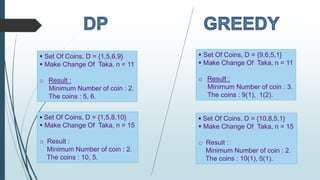Coin change Problem (DP & GREEDY)
- 1. TOPIC : COIN CHANGING (DP & GREEDY) WELCOME TO THE PRESENTATION
- 2. THINGS TO BE EXPLAINED: ? DP & Greedy ? Definition Of Coin Changing ? Example with explanation ? Time complexity ? Difference between DP & Greedy in Coin Change Problem
- 3. DP : DYNAMIC PROGRAMMING ? Dynamic programming is a method for solving a complex problem by breaking it down into a collection of simpler sub problems just once and storing their solutions. ? DP is used to solve problems with the following characteristics : ?Simple Sub problems ?Optimal Structure Of The Problems ?Overlapping Sub problems
- 4. GREEDY ALGORITHM ?A greedy algorithm always makes the choice that looks best at the moment. It makes a locally optimal choice in the hope that this choice will lead to a globally optimal solution. ?An algorithm is greedy if it builds a solution in small steps, choosing a decision at each step locally , not considering what happen ahead to optimize some underlying criterion
- 5. COIN CHANGE PROBLEM Coin change is the problem of finding the minimum number of ways of making changes for a particular amount of taka, using a given unlimited amounts of coins. It is a general case of Integer Partition.
- 6. D[1] = C[P ¨C D[1]] + 1; here D[1] = 1; = C[6 ¨C 1 ] +1; = C[5] +1 ; = 5 +1; = 6 MINIMUM NUMBER OF COINS EXAMPLE: Set Of Coins, D = { 1,5,6,9 } Make Change Of Taka, n = 11 0 1 2 3 4 1 1 2 3 1 2 3 1 1 1 1 5 6 1 1 9 5 C[P] = S[P] = 0 1 2 3 4 5 6 7 8 9 10 11 P 5 2 50 6 For P=6; D[2] = C[P ¨C D[1]] + 1; here D[2] = 5; = C[6 ¨C 5 ] +1; = C[1] +1 ; = 1+1; = 2 D[3] = C[P ¨C D[1]] + 1; here D[3] = 6; = C[6 ¨C 6] +1; = C[0] +1 ; = 0 +1; = 1 0, if P = 0 min ( C[P-D[i]] + 1 ), if P > 0 D[1] <= D[i] <=P C[P] =
- 7. EXPLANATION OF COIN CHANGE (DP) : C[P] = TIME COMPLEXITY: Time Complexity = O(m*n), where m = Total taka & n = Number of coin ? If D is unsorted , then sort D in Ascending Order ? Take two array C[P] and S[P] where, C[P] = Minimum number of coins used for P Tk S[P] = Last coin used to make P Tk. ? Fill the C[P] and S[P] tables ? Find C[P] using the following equation, 0, if P = 0 min ( C[P-D[i]] + 1 ), if P > 0 D[1] <= D[i] <=P
- 8. EXAMPLE: Set Of Coins, D = {9,6,5,1} Make Change Of Taka, n = 11 3. 2 / 6 = 2. 11 % 9 = 2 1. 11 / 9 = 5. 2 / 5 = 4. 2 % 6 = 2 6. 2 % 5 = 2 7. 2 / 1 = 8. 2 % 1 = 0 1 0 0 2 TAKEN COIN : 9(1) & 1(2)
- 9. ? If D is unsorted, then sort D in descending order. ? Find the taken coin and their minimum number using the following algorithm for(D[1] to D[n] ) { result = n/D[i]; n = n (mod) D[i]; if(result = 0) print result and D[i] } ? Repeat for each coin EXPLANATION OF COIN CHANGE (GREEDY): TIME COMPLEXITY: Time complexity = O(n), where n = Number of coin
- 10. ? Set Of Coins, D = {1,5,6,9} ? Make Change Of Taka, n = 11 o Result : Minimum Number of coin : 2. The coins : 5, 6. ? Set Of Coins, D = {1,5,8,10} ? Make Change Of Taka, n = 15 o Result : Minimum Number of coin : 2. The coins : 10, 5. ? Set Of Coins, D = {9,6,5,1} ? Make Change Of Taka, n = 11 o Result : Minimum Number of coin : 3. The coins : 9(1), 1(2). ? Set Of Coins, D = {10,8,5,1} ? Make Change Of Taka, n = 15 o Result : Minimum Number of coin : 2. The coins : 10(1), 5(1).
- 11. THANK YOU ANY QUESTIONS ??

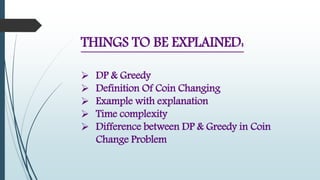
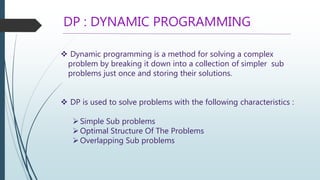
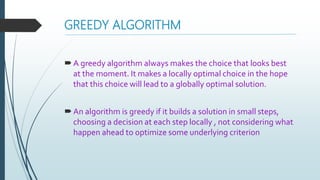

![D[1] = C[P ¨C D[1]] + 1; here D[1] = 1;
= C[6 ¨C 1 ] +1;
= C[5] +1 ;
= 5 +1;
= 6
MINIMUM
NUMBER
OF COINS
EXAMPLE:
Set Of Coins, D = { 1,5,6,9 }
Make Change Of Taka, n = 11
0 1 2 3 4 1 1 2 3 1 2 3
1 1 1 1 5 6 1 1 9 5
C[P] =
S[P] =
0 1 2 3 4 5 6 7 8 9 10 11 P
5
2
50 6
For P=6;
D[2] = C[P ¨C D[1]] + 1; here D[2] = 5;
= C[6 ¨C 5 ] +1;
= C[1] +1 ;
= 1+1;
= 2
D[3] = C[P ¨C D[1]] + 1; here D[3] = 6;
= C[6 ¨C 6] +1;
= C[0] +1 ;
= 0 +1;
= 1
0, if P = 0
min ( C[P-D[i]] + 1 ), if P > 0
D[1] <= D[i] <=P
C[P] =](https://image.slidesharecdn.com/coinchangingmain-180404155802/85/Coin-change-Problem-DP-GREEDY-6-320.jpg)
![EXPLANATION OF COIN CHANGE (DP) :
C[P] =
TIME COMPLEXITY:
Time Complexity = O(m*n), where m = Total taka & n = Number of coin
? If D is unsorted , then sort D in Ascending Order
? Take two array C[P] and S[P] where,
C[P] = Minimum number of coins used for P Tk
S[P] = Last coin used to make P Tk.
? Fill the C[P] and S[P] tables
? Find C[P] using the following equation,
0, if P = 0
min ( C[P-D[i]] + 1 ), if P > 0
D[1] <= D[i] <=P](https://image.slidesharecdn.com/coinchangingmain-180404155802/85/Coin-change-Problem-DP-GREEDY-7-320.jpg)
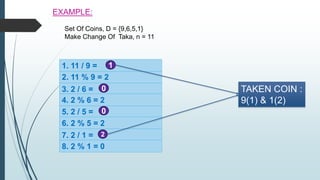
![? If D is unsorted, then sort D in descending order.
? Find the taken coin and their minimum number using the following algorithm
for(D[1] to D[n] )
{
result = n/D[i];
n = n (mod) D[i];
if(result = 0)
print result and D[i]
}
? Repeat for each coin
EXPLANATION OF COIN CHANGE (GREEDY):
TIME COMPLEXITY:
Time complexity = O(n), where n = Number of coin](https://image.slidesharecdn.com/coinchangingmain-180404155802/85/Coin-change-Problem-DP-GREEDY-9-320.jpg)
